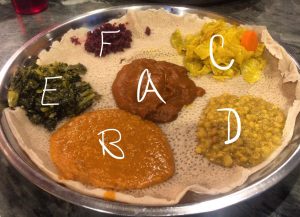The Experience
 The first time I had the opportunity to enjoy Habiba’s Ethiopian food was through My Luck Tummy. Those who are not familiar, My Lucky Tummy is a pop-up food court that hosts Refugees and New Americans in Syracuse as guest chefs, bringing more flavor to the area’s melting pot of cultures. Their last pop-up ever is next month as they are being absorbed into the Salt City Market, an up-and-coming Multinational Food Hall & Public Market scheduled to open in Syracuse in 2020.
The first time I had the opportunity to enjoy Habiba’s Ethiopian food was through My Luck Tummy. Those who are not familiar, My Lucky Tummy is a pop-up food court that hosts Refugees and New Americans in Syracuse as guest chefs, bringing more flavor to the area’s melting pot of cultures. Their last pop-up ever is next month as they are being absorbed into the Salt City Market, an up-and-coming Multinational Food Hall & Public Market scheduled to open in Syracuse in 2020.
The pop-ups were exciting and made you feel more involved in the local community, but what were you to do when you had a craving for some misir wot and injera the following week? Syracuse was missing an Ethiopian restaurant; a cuisine that naturally has ample vegan options. In October of last year, Chef Habiba Boru solved that problem with the opening of Habiba’s Ethiopian Kitchen at 656 North Salina St. Syracuse, NY, 13208.
Since I graduated SUNY-ESF in May of last year, I’ve been following the vegan options on the restaurant’s Instagram @habibasethiopiankitchen from afar. Well guess what? I’m back! Visiting that is, and Habiba’s was on the list of ‘To-Dos’. While not a 100% vegan restaurant, all items on the vegetarian menu are vegan, which includes the Veggie Sambusa on the appetizers menu.
With Alex Bruso, Syracuse Animal Rights Organization member, and Amy Cass, Syracuse Animal Rights Organization Vice President, as my wing vegans, we finally made it over for dinner on Thursday April 18 th at about 6pm. Street parking was easy to find and the place was packed. There’s about a dozen tables with a bar and every seat was filled! Fortunately we were able to get a seat within about 10 minutes.
The restaurant was lined with Ethiopian artwork, jebenas, and mesob woven baskets that, in addition to the food, gave a taste of the culture. Chef Habiba wonderfully outlines her Ethiopian culture and personal history on the restaurant’s website for further reading. While we waited to order, you could tell the people visiting were loving the food. A friendly family of fellow vegans heard us talking about the options while we waited and boasted about how much they loved it here. They helped ensure the Vegetarian Menu was vegan as they had been here previously. So happy to run into fellow vegans!
When it came time to order, all three of us picked the Beyaynetu Special for 1 person. It is offered for 2 people to split, but who are we kidding? We each wanted one all to ourselves. The Beyaynetu Special consists of all 6 items from the Vegetarian menu. If you’re not a fan of a specific item, they are willing to substitute it with double of something you do like. The entrees come with injera, but can be substituted for rice. If you’re gluten free, the everyday injera has gluten in it, but you can call during their open hours the day before you’re planning to visit and request GF injera for the next day! We also grabbed a couple Veggie Sambusas for an appetizer along with the Ethiopian Buna Coffee.
Anyone who knows me, knows I like spicy. My personal spice tolerance can handle over 6,000,000 scovilles. To put that in perspective, a sweet bell pepper has 0-100 scovilles. I’d hate if you found yourself munching on something I recommended and it’s too spicy for you to enjoy. Therefore, I’m describing each item below with the help of Amy and Alex to ensure normal palates are considered. I have also eaten at many Ethiopian restaurants in Chicago, the Twin Cities, and New York, so I have taken into account Amy’s experience, as this was her first time trying Ethiopian.
- If you have not had Ethiopian food before, here is what you need to know:
- I’d say it’s mix between the flavors of Indian and Soul Food, but it’s so much more than that.
- Some dishes are spicy. Some are not.
- Many dishes are flavored with berbere. This is a spice mix typically consisting of chili peppers, garlic, ginger, basil, cardamom, rue, ajwain or radhuni, cumin, and fenugreek. All of these come from plants.
- You eat your food with injera, a soft thin spongey sourdough ‘flat-bread’ made primarily of a fermented teff flour and yeast mixture.
- No, you do not use utensils.
- Yes, you use your hands.
- No, I don’t think anyone would shame you for using utensils, but it’s not how the food is eaten. You might get the same look that you get in my hometown of Chicago when putting ketchup on a hot dog, but that’s a story for another day.
- Place the food in your mouth, THEN chew. It’s not a pizza. You don’t need to chomp down while holding it.
The Food
You can find the full menu here.
Veggie Sambusa
A savory pastry filled with spices, corn, green beans, carrots, peas, onion, and what appeared to be lima beans. It’s fried to have a crispy outer shell and you get one per order. There’s a lightly understated sweet and sour thing going on with the seasoning. It was on the oily side. If you’ve had a samosa at one of Syracuse’s Indian restaurants before, it’s comparable.
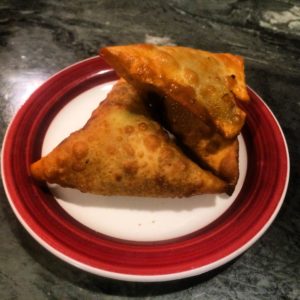
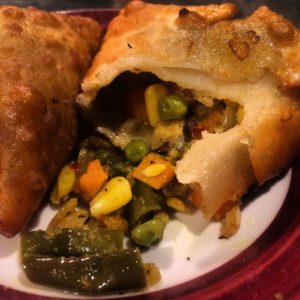
Injera
Amy really liked the injera. She said you could taste the sourdough-ness of it, but it didn’t overpower the dish you were eating with it. Alex mentioned that he got takeout orders here before and the injera gets soggy pretty fast if you don’t eat it right away. Of course I liked it, but me being picky I wish it was a little more sour.
A. Shiro Wot (Chickpeas)
Very spicy for the average palate. This ground chickpea ‘stew’ is smooth and has a plain initial flavor until it hits the further back of your tongue where the spice kicks in. It was Alex’s favorite and Amy’s least because Amy isn’t big into spicy.
B. Misir Wot (Lentils)
Less spicy than the shiro wot, but still spicy for the average palate. It’s not as spicy as I would have liked it, but I’m sure some of you out there are grateful for that. Also less textured than misir wot I’ve had in the past. It’s a mix of red lentils, berbere, garlic, and tomatoes that left me with a slight flavor coating on my tongue vaguely reminding me of a cheesy, nuttiness.
C. Atakilt Wot (Cabbage)
Flavorful, but not overpowering or spicy. I’ve had this at other places and it wasn’t as flavorful as it was here. The dish was mostly cabbage with some carrot. It says it comes with potato mixed in, but I didn’t get any potato with mine. This was one of Amy’s favorites.
D. Kik Alichi Wot (Split Peas)
Again, this dish was flavorful and not spicy. It was one of Amy’s top two. I normally don’t like this dish as much as I like misir wot, but it was really good. It’s mostly yellow split peas and is more textured than the shiro or misir wot.
E. Gomen Wot (Collard Greens)
This has a more ‘natural’ taste as Amy put it. The flavor is subtle and not salty. Sometimes dishes like this can come off as oily, but this one wasn’t. It had a consistency that I’m used to, but I think I was looking for a little more flavor from this one. Still yummy!
F. Kaye Siir (Beets)
Historically, this dish can be a hit or miss for me. At first taste, it had the sweetness you would expect from beets with savory undertones. After eating a little and revisiting it, I was able to taste the garlic and onion. The beets were also minced, which I’m not used to as many places I’ve been have large chunks of beets, but I liked it minced! It says it had potatoes mixed in, but
mine didn’t have potatoes and the portion size was notably different from the portions Amy and Alex got. I wouldn’t get this dish without something else accompanying it, but maybe if it had the potatoes I would change my mind.
Ethiopian Buna Coffee
There’s something about Ethiopian coffee poured into tiny cups from a jebena that I really like. Placebo effect or not, I feel like it makes the coffee taste better. I know that it is sometimes served this way at Habibas, based off of Instagram posts, but that wasn’t the case with our visit. It might have been because it was busy or it was later in the evening, but it came out already
poured in a regular coffee mug. It was still tasty though! Alex is more of a
coffee connoisseur than I and he really liked it. There isn’t non-dairy creamer
as far as we saw, but the sugar was vegan for those who are specific.
Overall
We really liked Habiba’s Ethiopian Kitchen. We all felt full, but not overly stuffed to the point of discomfort. We also felt like we had a relatively healthy meal. Definitely got our money’s worth. Amy’s even coming back soon with her husband in an effort to introduce even more local vegans to the world of Ethiopian food. Some quick notes. 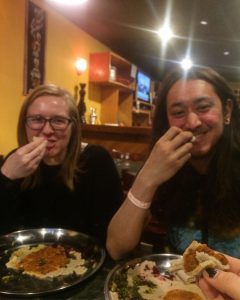 If you’re trying to be zero waste, note the takeout containers are Styrofoam so bring your own. The bathrooms are down a set of stairs, which wouldn’t work if you have a wheelchair. I don’t know if there’s another bathroom you could use, but something to consider. When the place is busy they might be overwhelmed. If you’re one of those people who’s real picky about service, which our group is not, stop by when it’s not a meal rush. We ended up staying about 20 minutes after closing. Chef Habiba herself made sure to check in with all remaining guests to see how they were enjoying their meal and apologized for any delay in serving the food. We didn’t feel rushed to leave and everyone was very helpful and nice. It would be great to see your thoughts on the food. Who knows? If the vegan community supports the options available at Syracuse’s first Ethiopian restaurant, maybe we’ll see new entrees or specials like a vegan Doro Alecha or Siga Wot. Now that’s something I haven’t had yet.
If you’re trying to be zero waste, note the takeout containers are Styrofoam so bring your own. The bathrooms are down a set of stairs, which wouldn’t work if you have a wheelchair. I don’t know if there’s another bathroom you could use, but something to consider. When the place is busy they might be overwhelmed. If you’re one of those people who’s real picky about service, which our group is not, stop by when it’s not a meal rush. We ended up staying about 20 minutes after closing. Chef Habiba herself made sure to check in with all remaining guests to see how they were enjoying their meal and apologized for any delay in serving the food. We didn’t feel rushed to leave and everyone was very helpful and nice. It would be great to see your thoughts on the food. Who knows? If the vegan community supports the options available at Syracuse’s first Ethiopian restaurant, maybe we’ll see new entrees or specials like a vegan Doro Alecha or Siga Wot. Now that’s something I haven’t had yet.
Thank you Chef Habiba for your hospitality!
Habiba’s Ethiopian Kitchen
656 North Salina Street
Syracuse, NY, 13208
United States
Phone: 315 299 4099
Hours
Monday: closed
Tues–Friday: 12pm–7pm
Saturday: 12pm–8pm
Sunday: closed
Want to highlight your favorite restaurant? Send us an email.
For a searchable list and interactive map of restaurants in and around Central New York, check out our guide here.


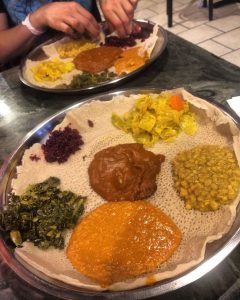
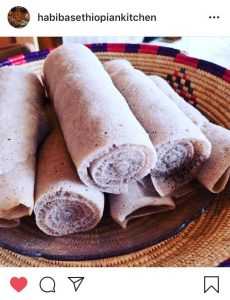 .
. 